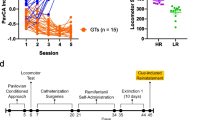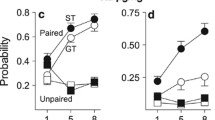Abstract
Rationale
In an animal model for vulnerability to drug abuse, rats that are more reactive to a novel environment (high responders, HRs) are more sensitive to behavioral effects of psychostimulants than are less reactive rats (low responders, LRs). In a companion article, we reported that HRs and LRs differ in sensitivity to morphine-induced locomotor sensitization.
Objective
We tested whether LRs and HRs also differ in sensitivity to opioid-induced antinociception and opioid antagonist-induced suppression of fluid consumption.
Methods
LRs and HRs were categorized based on motor responses to novelty during a 30-min session. Responses to nociceptive stimuli of varied intensities were measured using the tail-flick and hot-plate tests alone or following cumulative doses of morphine (1.0–12 mg/kg), buprenorphine (0.025–0.6 mg/kg), or etorphine (0.25–6.0 μg/kg). Potential changes in endogenous opioid-mediated reward systems were tested using naltrexone-induced (0.01–30 mg/kg) suppression of drinking either water following 24-h deprivation or sweetened condensed milk in a non-deprived state. These effects were further examined following 2 weeks of daily access to sweetened condensed milk.
Results
At the lowest stimulus intensity tested, HRs had significantly shorter tail-flick response latencies than LRs. Additionally, HRs were less responsive to cumulative doses of morphine than LRs. There were no overall group differences in the hot-plate test. Following 2 weeks of daily access to sweetened condensed milk, HRs were more sensitive to naltrexone-induced suppression of consumption.
Conclusions
Under the proper conditions, differences in sensitivity to opioid drugs between HRs and LRs at least partially extend to antinociceptive and appetitive reward systems and are suggestive of more extensive differences in phenotype. As with the effects of repeated morphine exposure on locomotor activity, the effect of repeated exposure to appetitive reward associated with sweetened milk appears to be more robust in LRs than HRs.






Similar content being viewed by others
References
Adams JU, Paronis CA, Holtzman SG (1990) Assessment of relative intrinsic activity of mu-opioid analgesics in vivo by using beta-funaltrexamine. J Pharmacol Exp Ther 255:1027–1032
Agmo A, Galvan A, Talamantes B (1995) Reward and reinforcement produced by drinking sucrose: two processes that may depend on different neurotransmitters. Pharmacol Biochem Behav 52:403–414
Bardo MT, Donohew RL, Harrington NG (1996) Psychobiology of novelty seeking and drug seeking behavior. Behav Brain Res 77:23–43
Bevins RA, Klebaur JE, Bardo MT (1997) Individual differences in response to novelty, amphetamine-induced activity and drug discrimination in rats. Behav Pharmacol 8:113–123
Brennan K, Roberts DC, Anisman H, Merali Z (2001) Individual differences in sucrose consumption in the rat: motivational and neurochemical correlates of hedonia. Psychopharmacology 157:269–276
Brown DR, Holtzman SG (1979) Suppression of deprivation-induced food and water intake in rats and mice by naloxone. Pharmacol Biochem Behav 11:567–573
Conway CM, Martinez J, Lytle LD (1998) Maturational changes in the thermal nociceptive responses of developing rats. Dev Psychobiol 33:47–60
Cook CD, Barrett AC, Roach EL, Bowman JR, Picker MJ (2000) Sex-related differences in the antinociceptive effects of opioids: importance of rat genotype, nociceptive stimulus intensity, and efficacy at the mu opioid receptor. Psychopharmacology 150:430–442
D’Amour FE, Smith DL (1941) A method of determining loss of pain sensation. J Pharmacol Exp Ther 72:74–79
Dellu F, Piazza PV, Mayo W, Le Moal M, Simon H (1996) Novelty-seeking in rats-biobehavioral characteristics and possible relationship with the sensation-seeking trait in man. Neuropsychobiology 34:136–145
Deroche V, Piazza PV, Le Moal M, Simon H (1993) Individual differences in the psychomotor effects of morphine are predicted by reactivity to novelty and influenced by corticosterone secretion. Brain Res 623:341–344
Dewey WL, Harris LS (1975) The tail flick test. Methods in narcotic research. Dekker, New York, pp 101–109
Emmerson PJ, Clark MJ, Mansour A, Akil H, Woods JH, Medzihradsky F (1996) Characterization of opioid agonist efficacy in a C6 glioma cell line expressing the mu opioid receptor. J Pharmacol Exp Ther 278:1121–1127
Erb SM, Parker LA (1994) Individual differences in novelty-induced activity do not predict strength of amphetamine-induced place conditioning. Pharmacol Biochem Behav 48:581–586
Gellert VF, Holtzman SG (1978) Development and maintenance of morphine tolerance and dependence in the rat by scheduled access to morphine drinking solutions. J Pharmacol Exp Ther 205:536–546
Gong W, Neill DB, Justice JB (1996) Locomotor response to novelty does not predict cocaine place preference conditioning in rats. Pharmacol Biochem Behav 53:191–196
Grossman ML, Basbaum AI, Fields HL (1982) Afferent and efferent connections of the rat tail flick reflex (a model used to analyze pain control mechanisms). J Comp Neurol 206:9–16
Holtzman SG (1974) Behavioral effects of separate and combined administration of naloxone and d-amphetamine. J Pharmacol Exp Ther 189:51–60
Holtzman SG (1979) Suppression of appetitive behavior in the rat by naloxone: lack of effect of prior morphine dependence. Life Sci 24:219–226
Hooks MS, Jones GH, Smith AD, Neill DB, Justice JB Jr (1991a) Individual differences in locomotor activity and sensitization. Pharmacol Biochem Behav 38:467–470
Hooks MS, Jones GH, Smith AD, Neill DB, Justice JB Jr (1991b) Response to novelty predicts the locomotor and nucleus accumbens dopamine response to cocaine. Synapse 9:121–128
Hooks MS, Colvin AC, Juncos JL, Justice JB Jr (1992a) Individual differences in basal and cocaine-stimulated extracellular dopamine in the nucleus accumbens using quantitative microdialysis. Brain Res 587:306–312
Hooks MS, Jones GH, Liem BJ, Justice JB Jr (1992b) Sensitization and individual differences to IP amphetamine, cocaine, or caffeine following repeated intracranial amphetamine infusions. Pharmacol Biochem Behav 43:815–823
Hoshaw BA, Lewis MJ (2001) Behavioral sensitization to ethanol in rats: evidence from the Sprague-Dawley strain. Pharmacol Biochem Behav 68:685–690
Jodogne C, Marinelli M, Le Moal M, Piazza PV (1994) Animals predisposed to develop amphetamine self-administration show higher susceptibility to develop contextual conditioning of both amphetamine-induced hyperlocomotion and sensitization. Brain Res 657:236–244
Kalinichev M, Easterling KW, Holtzman SG (2000) Periodic postpartum separation from the offspring results in long- lasting changes in anxiety-related behaviors and sensitivity to morphine in Long–Evans mother rats. Psychopharmacology 152:431–439
Kalinichev M, White DA, Holtzman SG (2004) Individualdifferences in locomotor reactivity to a novel environment and sensitivity toopioid drugs in the rat I. Morphine-induced locomotor sensitization andtolerance. Psychopharmacology (in press)
Klebaur JE, Bardo MT (1999) Individual differences in novelty seeking on the playground maze predict amphetamine conditioned place preference. Pharmacol Biochem Behav 63:131–136
Kosten TA, Miserendino MJ (1998) Dissociation of novelty- and cocaine-conditioned locomotor activity from cocaine place conditioning. Pharmacol Biochem Behav 60:785–791
Levine AS, Billington CJ (1989) Opioids. Are they regulators of feeding? Ann NY Acad Sci 575:209–219
Locke KW, Brown DR, Holtzman SG (1982) Effects of opiate antagonists and putative mu- and kappa-agonists on milk intake in rat and squirrel monkey. Pharmacol Biochem Behav 17:1275–1279
Mantsch JR, Ho A, Schlussman SD, Kreek MJ (2001) Predictable individual differences in the initiation of cocaine self- administration by rats under extended-access conditions are dose-dependent. Psychopharmacology 157:31–39
Morley JE, Levine AS, Yim GK, Lowy MT (1983) Opioid modulation of appetite. Neurosci Biobehav Rev 7:281–305
O’Callaghan JP, Holtzman SG (1975) Quantification of the analgesic activity of narcotic antagonists by a modified hot-plate procedure. J Pharmacol Exp Ther 192:497–505
Paolone G, Burdino R, Badiani A (2003) Dissociation in the modulatory effects of environmental novelty on the locomotor, analgesic, and eating response to acute and repeated morphine in the rat. Psychopharmacology 166:146–155
Paronis CA, Holtzman SG (1991) Increased analgesic potency of mu agonists after continuous naloxone infusion in rats. J Pharmacol Exp Ther 259:582–589
Piazza PV, Deminiere JM, Le Moal M, Simon H (1989) Factors that predict individual vulnerability to amphetamine self-administration. Science 245:1511–1513
Piazza PV, Rouge-Pont F, Deminiere JM, Kharoubi M, Le Moal M, Simon H (1991) Dopaminergic activity is reduced in the prefrontal cortex and increased in the nucleus accumbens of rats predisposed to develop amphetamine self-administration. Brain Res 567:169–174
Piazza PV, Deroche V, Deminiere JM, Maccari S, Le Moal M, Simon H (1993) Corticosterone in the range of stress-induced levels possesses reinforcing properties: implications for sensation-seeking behaviors. Proc Natl Acad Sci U S A 90:11738–11742
Robinet PM, Rowlett J, Bardo MT (1998) Individual differences innovelty-induced activity and the rewarding effects of novelty and amphetaminein rats. Behav Process 44:1–9
Rouge-Pont F, Piazza PV, Kharouby M, Le Moal M, Simon H (1993) Higher and longer stress-induced increase in dopamine concentrations in the nucleus accumbens of animals predisposed to amphetamine self-administration. A microdialysis study. Brain Res 602:169–174
Selley DE, Liu Q, Childers SR (1998) Signal transduction correlates of mu opioid agonist intrinsic efficacy: receptor-stimulated [35S]GTP gamma S binding in mMOR-CHO cells and rat thalamus. J Pharmacol Exp Ther 285:496–505
Smith MA, Gray JD (2001) Age-related differences in sensitivity to the antinociceptive effects of opioids in male rats. Influence of nociceptive intensity and intrinsic efficacy at the mu receptor. Psychopharmacology 156:445–453
Vitale MA, Chen D, Kanarek RB (2003) Chronic access to a sucrose solution enhances the development of conditioned place preferences for fentanyl and amphetamine in male Long–Evans rats. Pharmacol Biochem Behav 74:529–539
Way EL, Loh HH, Shen FH (1969) Simultaneous quantitative assessment of morphine tolerance and physical dependence. J Pharmacol Exp Ther 167:1–8
Willner P (1984) The validity of animal models of depression. Psychopharmacology 83:1–16
Yaksh TL (1981) Spinal opiate analgesia: characteristics and principles of action. Pain 11:293–346
Acknowledgments
This study was supported by NIH grant DA11384 and Senior Scientist Award K05 DA00008 to S.G.H.
Author information
Authors and Affiliations
Corresponding author
Rights and permissions
About this article
Cite this article
White, D.A., Kalinichev, M. & Holtzman, S.G. Individual differences in locomotor reactivity to a novel environment and sensitivity to opioid drugs in the rat. II. Agonist-induced antinociception and antagonist-induced suppression of fluid consumption. Psychopharmacology 177, 68–78 (2004). https://doi.org/10.1007/s00213-004-1921-8
Received:
Accepted:
Published:
Issue Date:
DOI: https://doi.org/10.1007/s00213-004-1921-8




